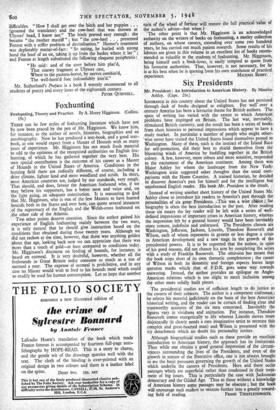Foxhunting
Foxhunting, Theory and Practice. By A. Henry Higginson. (Collins. 15s.)
THERE can be few styles of foxhunting literature which have not by now been graced by the pen of Mr. Higginson. We know him, for instance, as the author of novels, histories, biographies and an autobiography. Now he has produced a text-book, and a good text- book, as one would expect from a Master of Hounds with so many years of experience. Mr. Higginson has not much fresh material to add to the opinions of the recognised authorities on English fox- hunting, of which he has gathered together the very best. His own special contribution is the outcome of his career as a Master of Hounds in the United States of America. Conditions in the hunting field there are radically different, of course, including a drier climate, lighter land and more woodland and scrub. In short, most American countries are, judged by our standards, very rough; That should, and does, favour the American foxhound who, if we may believe his supporters, has a better nose and voice and, on the light going, an adequate constitution. It is reassuring to find that Mr. Higginson, who is one of the -few Masters to have hunted hounds both in the States and over here, can quote several instances of the supremacy of the English and the Welsh-cross foxhound on the other side of the Atlantic.
Two other points deserve attention. Since the author gained his experience of English foxhunting mainly between the two wars, it is only natural that he should give instruction based on the conditions that obtained during those twenty years. Although we did not reckon at the time, however, that there was anything golden about that age, looking back now we can appreciate that there was More than a touch of gold—at least compared to conditions today. Mr. Higginson's discourse on feeding of hounds, for instance, is based on oatmeal. It is very doubtful, however, whether all the foxhounds in Great Britain today consume as much as a ton of oatmeal a year. The expense of oatmeal is prohibitive, and in any case no Master would wish to feed to his hounds meal which could so readily be used for human consumption. Let us hope that another
turn of the wheel of fortune will restore the full practical value of the author's advice—but when ?
The other point is that Mr. Higginson is an acknowledged authority on the writers of books on foxhunting, a motley collection of authors, on whose careers, extending over some two hundred years, he has carried out much patient research. Some results of his labours are given in this volume in an excellent list of books recom- mended as valuable to the students of foxhunting. Mr. Higginson,, being himself such a book-lover, is easily tempted to quote from his favourite authorities. That, however, is not necessary, for he is at his best when he is quoting from his own storehouse of practical










































 Previous page
Previous page